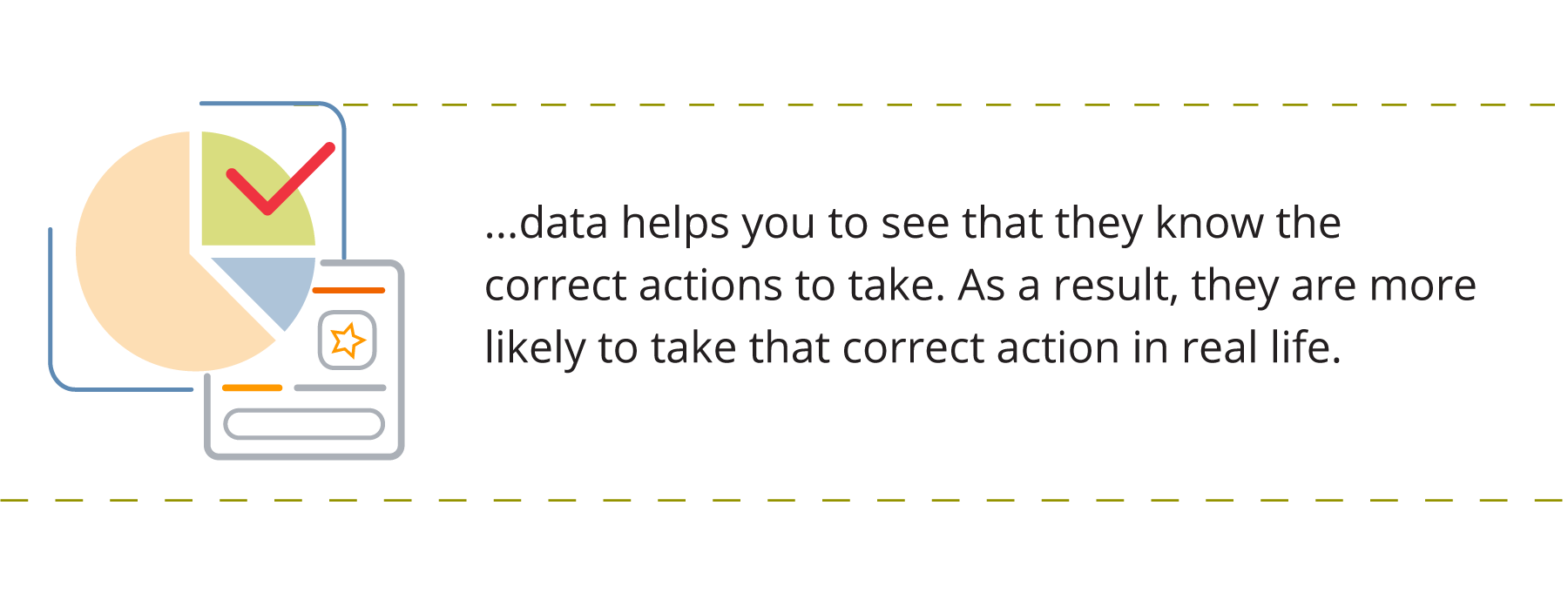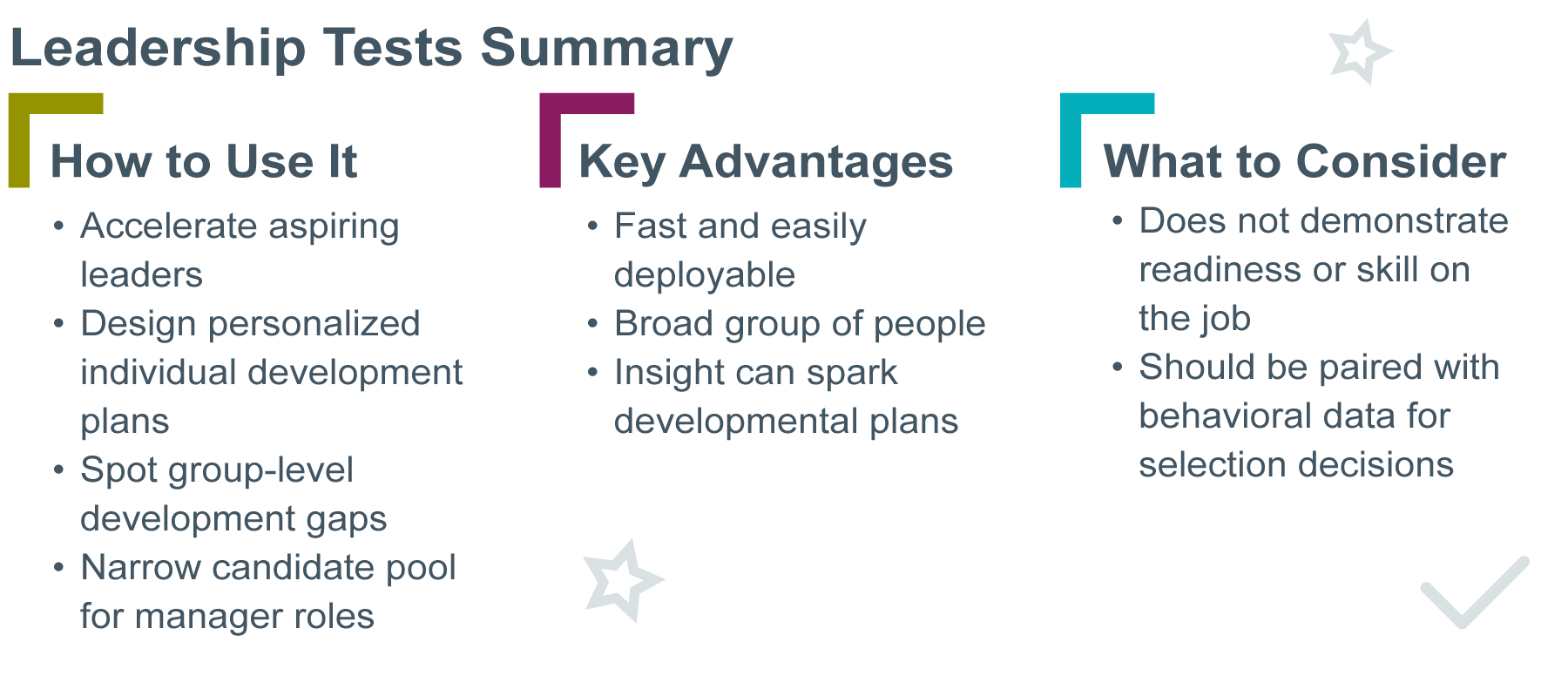Tests Help You Get Data Fast
Is an assessment a test, and is a test an assessment? We often hear questions like this, and a lot of confusion about how to use leadership tests.
So, let’s start with getting the terms clear. You’ve likely heard the two words “test” and “assessment” used interchangeably. But it’s important to highlight what makes a test unique compared to other types of assessments.

What Is a Leadership Test?
A leadership test is a series of questions (usually closed-ended) designed to gather data on a leader’s intelligence, knowledge, judgment, personality, and/or preferences. Tests almost always have entirely automated scoring.
In most cases, HR uses tests to screen or shortlist a large group of people. That’s because they are online, fully automated, and easy to scale for a high volume of users. Our discussion will focus on tests designed specifically for early leadership roles.
You may be familiar with some of these common types of test questions:
- Extent of agreement with a statement: Leaders are presented with a statement, then select a rating ranging from “Strongly Agree” to “Strongly Disagree.”
- Forced choice: Leaders choose between options, without the ability to select “neutral” or “I don’t know.”
- Situational judgment: Leaders are presented with a situation and given multiple choices about how they would respond.
- Action effectiveness items: Leaders are presented with a situation and a series of potential actions in response to it. They then rate the effectiveness of each potential action.
Leadership tests capture the “signs” type of data. Some of these signs, such as the situational judgment and action effectiveness items, help you to see that the person knows the correct actions to take. As a result, they are more likely to take that correct action in real life than someone who answered incorrectly.
However, they do not offer a true sample of work. So, you won’t know that they have the skill to take that action.

When Should I Use a Leadership Test?
A leadership test is a relatively quick and easy way to get data as you look to hire, promote, or develop leaders. Consider a leadership test if you need to:
- Accelerate high-performing individual contributors. High-performing individual contributors or aspiring leaders can take a leadership test to boost their careers. The results can provide valuable data points to help determine who is most likely to succeed as a leader. You can then determine next steps to prepare top performers for a leadership position or a more challenging role.
- Design personalized individual development plans. Based on individual results, you can create targeted individual development plans. For example, if someone shows a gap in delegating skills, their manager can provide specific best practices or tools, assign an online course on delegation, or give an assignment to encourage effective delegation.
- Use group-level data to design development programs. Aggregate reports can inform trends related to group strengths and development opportunities. For example, if you see that several teams have a gap in influencing others, you can choose to include some content on influencing skills in a cohort-based or on-demand program.
- Increase confidence in selection decisions. A leadership test can give you data on candidates early in the process. This provides you with more effective interviews and focused next steps. With a valid leadership test, candidates with higher test scores should ramp up more quickly and are more likely to succeed in a leadership role.
When Should I NOT Use a Leadership Test?
It can be tempting to rely on leadership tests for all your data needs. They're easy to administer and you can typically get the results immediately. But here are situations when we would not recommend tests:
- As an end-all and be-all for selection decisions: Given the limitations of what a leadership test can measure, it should not be used as the only data point to hire or promote leaders. A single test will not give you enough insights into the behaviors or motivations or other important aspects critical for a leadership role. Beware of tests that promise too much!
- When depth of insight matters: If you’re looking to provide your leaders with a high-level view of strengths and development areas, then a leadership test might meet the need. But if you’re looking to provide more in-depth insights to pinpoint specific behaviors, then a more immersive assessment might be required, especially for high-potential leaders you’re looking to accelerate quickly.
- When you’re trying to answer the readiness question: In succession situations, you may be trying to determine who’s ready to move into a leadership role and find skill gaps. In these cases, a simulation-based leadership assessment where you can observe how a leader responds to various challenges specific to that next-level role will be more appropriate.
- Performance management: It would not be appropriate to use a leadership test as part of the performance management process. A person’s performance evaluation should be based on their on-the-job performance, not on the outcome of a leadership test.
How a Leadership Test Works
A leadership test requires several steps to be effective. These steps include:
- Step 1: Select a test that’s relevant to the competencies required for success. You don’t want to try to force-fit the results of a test that’s really designed for a different purpose.
- Step 2: Establish a data sharing policy. Who will have access to the data and for what purpose? For development purposes, we recommend that both leaders and their managers have access to the report. With external hires, candidates may not see the results unless they are eventually hired. Then they can have access to the data as part of their onboarding. For internal promotion, you can determine who gets the data, when, and why.
- Step 3: Train hiring managers on how to use and interpret the results.
- Step 4: HR administrators set up a platform for participants to access the test online.
- Step 5: Leaders complete the test in one sitting and within a given time frame.
- Step 6: Results can be available almost immediately.
- Step 7: Analyze individual and group-level results for next steps.
How Much of a Time Commitment Is a Leadership Test?
Compared to other assessment types, a leadership test requires the least amount of time. For you and your HR team, an automated test will typically involve minimal set-up steps. It requires names, email addresses, and any additional demographic details you want to track. It sends self-service emails afterward.
Depending on the type of test, it may take 30 to 60 minutes to complete a leadership test.
Beyond the administration and completion of the test, time should also be scheduled to review the results and plan next steps.
What Are the Common Pitfalls with Leadership Tests?
Based on our experience working with clients, there are several leadership test pitfalls. Some common leadership test pitfalls you can avoid include:
- Unclear purpose and expectations. Inform your leaders if the test results will be used for development planning or promotion decisions, or both. Also, be clear about your data sharing policy and expectations after completing the test.
- Viewing test results as a pass or fail. In a leader selection process, the real value of a leadership test is having an additional data point to combine with other selection measures like existing performance data and behavioral interview data. Using a test as a pass or fail is more appropriate in high-volume testing situations.
- Expecting too much from test results. A test can only do so much. A test does not assess actual behaviors. It presents a snapshot of leaders’ knowledge, judgment, or perspectives at that point in time. It can’t effectively capture leadership behaviors required for success.
- Not having a plan after the test. Especially if a test is used for development, the main payoff to the leader are the insights around their strengths and development areas.
- Forgetting to train managers on report interpretation. While the results of a leadership test should be fairly clear, it’s important to teach hiring managers how to use the results. For example, they should know how to use them to probe for more information in an interview. They also need to know how heavily to weight the results in their hiring decision. And once they’ve made their decision, they need to know how to feed the results into a development plan.
What Else Should I Use with Leadership Tests?
A view of the bigger picture can help you make better talent decisions. It is best to supplement leadership tests with a behavioral assessment tool to observe specific actions or get sample behaviors.
For example, you can pair a leadership test with a behavioral interview to get concrete examples of past behavior. Or after a test, you can immerse leaders in a day-in-the-life assessment to measure current skills and development areas.

